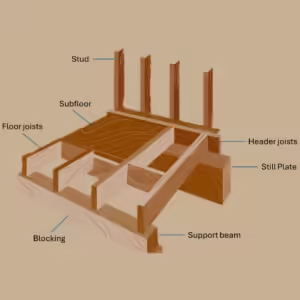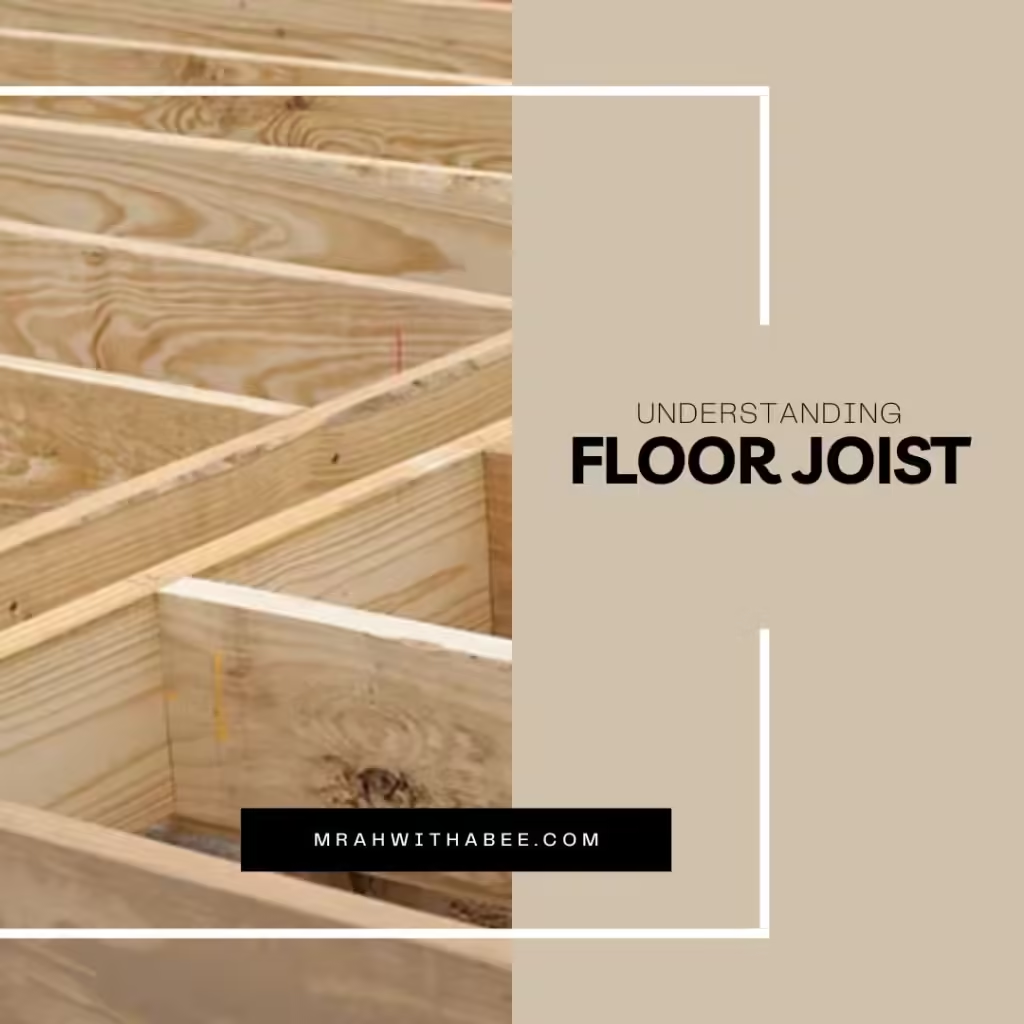Floor joist is an essential structural component in any building, playing a critical role in ensuring that floors are strong, level, and safe for use. These horizontal beams are positioned beneath the flooring and run parallel to each other, forming the foundation for every level of a building. In this blog post, we will discuss what makes floor joists the key component of a building structure, the types of floor joists, and how they work. If you want to skip to the blog’s specific portion, click on the TOC heading you are interested in reading about.
What Are Floor Joists?
Floor joists are horizontal structural components that span open spaces, typically positioned between beams. They transfer loads to vertical structural elements, forming an integral part of the floor system. These joists support the weight of everything within a room, including walls, furniture, appliances, and occupants. Generally, floor joists are spaced 16 inches apart on the center, although this distance can vary based on building codes and structural requirements outlined in the blueprint.
Floor joists play a crucial role in load distribution throughout a structure. When weight is applied to the floor, the wood fibers on the underside of the joist experience tension, while the upper fibers undergo compression. This dynamic helps to evenly distribute the load across the joists, ensuring stability and safety.
Understanding the Structure of a Floor Frame

Before constructing your frame, ensure that the ground is compacted and the foundation is solid. Here are the key components of a floor frame (note: this is not an exhaustive list of all elements involved):
Joists
Horizontal structural members, commonly known as floor joists, play a crucial role in supporting the floor system of a building. These joists are strategically positioned to run between beams or walls, effectively distributing weight across the entire floor area. By spanning open spaces, floor joists bear the load of everything above them, including flooring materials, furniture, appliances, and even the occupants of the space. Their design is essential for maintaining structural integrity, as they help to prevent sagging or uneven surfaces that could pose safety risks.
The placement and spacing of joists are carefully calculated based on the building’s specific requirements, ensuring that they can handle the anticipated loads. This distribution of weight minimizes stress on individual joists, allowing for a balanced and stable floor. Additionally, floor joists can also accommodate utilities such as plumbing and electrical lines, making them an integral part of the overall building framework.
Beams
Larger horizontal members, often referred to as beams, are essential components of a floor frame that provide critical support to the entire structure. These beams serve as the backbone of the floor system, effectively carrying the weight of the floor joists and any additional loads placed upon them. Beams are typically made from strong materials such as wood, steel, or engineered wood products, allowing them to withstand significant stress and strain. They span longer distances than joists, connecting various points of the structure and evenly distributing weight across vertical supports, such as columns or walls.
By transferring loads from the joists to these vertical supports, beams play a vital role in maintaining the structural integrity of the building. This load distribution helps to prevent excessive bending or sagging of both the beams and the joists, ensuring a stable and level floor surface. In addition to their primary function of support, beams can also accommodate other structural needs. They may be designed to host utilities such as ductwork, plumbing, or electrical conduits, which can run along or through them without compromising the overall strength of the frame.
Still Plates
Sill plates are essential horizontal boards in a floor frame that connect the foundation to the building structure. Anchored directly to the foundation, they provide a stable base for the floor frame and secure attachment points for vertical walls and other components, preventing lateral movement and ensuring overall stability. This anchoring is especially important in areas prone to shifting soils or seismic activity, as it provides additional resistance against potential structural displacement.
Typically made from treated lumber to resist moisture and decay, sill plates enhance the durability of the building, especially in areas with shifting soils or seismic risks. They also help distribute loads evenly across the foundation, supporting the weight of walls and upper floors. Additionally, sill plates can facilitate the installation of insulation and moisture barriers, improving energy efficiency and protecting against water intrusion.
Blocking
Blocking consists of short pieces of wood installed between floor joists to improve the stability of the floor system. These blocks serve several important functions.
- Primarily, blocking prevents twisting and warping of the joists, providing additional support that creates a more rigid framework. This stability is crucial in areas subject to heavy loads or foot traffic, reducing the risk of sagging or uneven floors.
- Additionally, blocking supports various fixtures, such as plumbing pipes, electrical wiring, and HVAC ducts, ensuring they are securely anchored and minimizing the risk of damage. This is especially beneficial in complex installations where multiple systems coexist.
Blocking also enhances soundproofing by reducing joist movement, helping to dampen vibrations and noise transfer for a quieter living or working environment.
Subflooring
The subfloor is an essential layer, usually made from plywood or oriented strand board (OSB), installed directly on top of the floor joists. It serves as the foundational surface that supports finished flooring materials like hardwood, laminate, tile, or carpet.
- Its primary function is to provide a solid and stable base, distributing the weight of the flooring evenly across the joists. This helps prevent sagging or movement that could damage the floor over time, ensuring both aesthetic appeal and durability.
- In addition to structural support, the subfloor contributes to insulation and soundproofing, reducing noise transmission between floors and helping maintain comfortable indoor temperatures.
- The subfloor acts as a moisture barrier, protecting the finished flooring from humidity and water damage, especially in damp areas like basements or bathrooms.
Proper installation is crucial; securely fasten the subfloor to the joists with nails or screws. Techniques like staggered joints and adequate spacing enhance its strength and resilience.
Types of Floor Joists

There are several types of floor joists, each with unique advantages:
- Solid Lumber Joists: Made from solid wood, these are traditional and affordable but can warp over time.
- Engineered Wood Joists (e.g., I-Joists, LVL): Made from layers of wood and adhesives, these are lightweight and strong.
- Open-web Floor Trusses: Open-web floor trusses are lightweight, strong structures that allow for long spans and easy utility installation.
Each type offers different load capacities, costs, and durability. Here is a detailed description of each type of joist.
Solid Lumber Joists
Solid lumber joists are constructed from solid wood, making them a traditional choice for many building projects. These joists offer affordability and availability, as builders can often source them readily from local lumber yards. However, one drawback is that solid lumber can warp, twist, or shrink over time due to changes in humidity and temperature, which can affect the integrity of the floor system. Typically, solid lumber joists are spaced 16 inches apart on center, although this spacing can vary based on the specific design requirements and building codes.
Engineered Wood Joists (e.g., I-Joists, LVL)
Engineered wood joists, like I-joists and LVL, consist of layers of wood and adhesives, offering a strong and efficient alternative to solid lumber. These joists are lightweight yet strong, allowing for longer spans without the need for additional support. Their design minimizes the risk of warping and twisting, making them a stable choice for modern construction. Engineered wood joists are often spaced 16 inches to 24 inches apart on center, depending on the load requirements and the specific product specifications.
Open-Web Floor Trusses
Open-web floor trusses are another innovative option for floor framing. These trusses consist of a series of interconnected members that form a web-like structure, allowing for significant strength while maintaining a lightweight design. The open design of these trusses provides ample space for running ductwork, plumbing, and electrical lines, making them a practical choice for many building projects. Open-web floor trusses are typically spaced 24 inches apart on center, providing flexibility in design while ensuring structural integrity.
Common Issues with Floor Joists
Floor joists can encounter several common issues that affect their integrity and performance:
Sagging
Sagging occurs when floor joists are subjected to excess weight or are improperly spaced. Overloading a floor with heavy furniture, appliances, or other loads can lead to noticeable dips or sagging in the floor surface. Additionally, if builders space the joists too far apart, they cannot provide adequate support, leading to structural weaknesses. This sagging can not only compromise the aesthetic appeal of the floor but also pose safety risks for occupants.
Warping
Warping is a common problem, particularly with wooden joists, and is primarily caused by exposure to moisture. When wood absorbs moisture, it can expand and contract, resulting in twists, bends, or curves in the joists. This warping can lead to uneven floors and may affect the installation of finished flooring materials. It’s important to manage humidity levels and ensure proper ventilation to minimize the risk of warping.
Rot
Rot is a serious issue that arises from prolonged moisture exposure in wooden joists. This decay can occur in areas like basements, crawl spaces, or any other damp environments where moisture is prevalent. When wood rots, it loses its structural integrity, making the joists weak and potentially unsafe. Rot can also attract pests like termites, further compromising the strength of the floor system. Regular inspections and moisture control measures are essential to prevent rot and ensure the longevity of floor joists. Mold in floor joists can weaken structures and pose health risks, often caused by moisture, poor ventilation, and leaks.
Regular inspections help catch these issues early, preventing costly repairs.
Repairing and Replacing Floor Joists
Minor damage to floor joists can often be addressed through reinforcement techniques or by adding support beams. This approach can include sistering new joists alongside the damaged ones or installing additional beams to redistribute weight and enhance stability. Such repairs can effectively restore the structural integrity of the floor without the need for extensive work.
However, in cases of severe damage—such as significant rot, extensive cracking, or severe warping—replacement of the joists may be necessary. This process involves removing the compromised joists and installing new ones that meet current building codes and safety standards. Replacing joists is more labor-intensive and requires careful planning to ensure that the structure remains stable throughout the process.
Conclusion
Floor joists are fundamental to any structure, providing necessary support and ensuring stability. Regular inspections, understanding spacing, and choosing the right materials can help maintain a safe and durable floor system.
FAQs
- How far apart are floor joists?
Floor joists are typically spaced 16 inches apart, but this can vary based on load requirements and building codes. - What is a floor joist?
A floor joist is a horizontal beam that supports the weight of a floor, transferring the load to walls or support beams. - Can I add new floor joists to strengthen an old floor?
Yes, adding new joists, called “sistering,” can reinforce weakened or sagging floors. - What’s the difference between floor joist and ceiling joist?
Floor joists support the weight of floors while ceiling joists primarily support the ceiling and provide attic floor support. - How do I know if my floor joists need repair?
Signs include creaking, sagging floors, or visible damage like cracks, warping or rot. - What wood type is best for floor joist?
Common choices are pine, Douglas fir, and engineered wood, all of which offer strength and durability. - How long do floor joists typically last?
Properly installed and maintained joists can last 50+ years, but environmental factors may affect this lifespan. - Can floor joist carry an extra load, like a heavy aquarium?
Consult a structural engineer, as joists have specific load limits. Reinforcements may be necessary for heavy items. - What are engineered floor joists, and are they better than solid wood?
Engineered joists (like I-joists) offer high strength and durability, especially for long spans, but come at a higher cost. - Are floor joists fire-resistant?
Standard wood joists aren’t fire-resistant, but there are fire-retardant treatments for added safety in some cases. - How to sister a floor joist?
To sister a floor joist, add a second joist alongside an existing one for extra support.
Thank you for reading, for more interesting articles visit our homepage.



